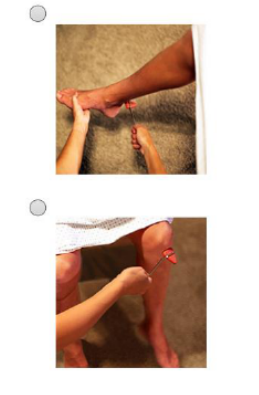ATI RN
RN ATI FUNDAMENTALS 2024 EXAM Questions
Extract:
Question 1 of 5
A nurse is using an open irrigation technique to irrigate a client's indwelling urinary catheter. Which of the following actions should the nurse take?
Correct Answer: C
Rationale: The correct answer is C: Subtract the amount of irrigant used from the client's urine output. This is the correct action because when using open irrigation technique, the nurse needs to account for the amount of irrigant introduced into the catheter to accurately assess the client's urine output. By subtracting the amount of irrigant used from the total output, the nurse ensures an accurate measurement of the client's urine output. This is crucial for monitoring the client's renal function and fluid balance.
Choice A is incorrect as the client should ideally be in a supine position during catheter irrigation to prevent spillage.
Choice B is incorrect as the amount of irrigation fluid instilled should typically be equal to the amount of urine output, not a fixed amount.
Choice D is incorrect as a 60-mL syringe is usually recommended for catheter irrigation to avoid excessive force and pressure on the catheter.
Question 2 of 5
A nurse on a medical-surgical unit is caring for a client who has a new prescription for wrist restraints. Which of the following actions should the nurse take?
Correct Answer: A
Rationale: The correct answer is A: Pad the client's wrist before applying the restraints. This is important to prevent pressure injuries and ensure the client's comfort and safety. Padding helps distribute pressure and reduces the risk of skin breakdown.
Choices B, C, and D are incorrect. B is not recommended as it is essential to monitor circulation frequently, not just every 8 hours. C is incorrect because restraints should not be removed without a valid reason due to the risk of injury or harm to the client. D is also wrong as restraints should be secured to parts of the bed frame, not side rails, to prevent the client from using them to injure themselves or others.
Extract:
Vital signs:Temperature 36.2° C (97.2° F) Pulse rate 116/min Respiratory rate 24/min BP 102/68 mm Hg Oxygen saturation 95% Weight 52.2 kg (115 Ib
Question 3 of 5
A nurse in a provider's clinic is caring for a client who has diarrhea. The nurse is providing teaching for the client. Select the 4 instructions the nurse should include in the teaching.
Correct Answer: B, C, F, G
Rationale: The correct instructions for the nurse to include are B, C, F, and G.
B: Probiotic foods like yogurt can help restore gut health.
C: Alcohol can worsen diarrhea, so it's important to avoid it.
F: Caffeine can be irritating to the digestive system, so avoiding it is beneficial.
G: Drinking lots of fluids helps prevent dehydration from diarrhea.
These instructions are essential for managing diarrhea effectively.
Incorrect options:
A: High-calcium foods may not be well-tolerated during diarrhea.
D: Raw vegetables can be difficult to digest during diarrhea.
E: Eating three large meals can be too much for a digestive system experiencing diarrhea.
Extract:
Question 4 of 5
A nurse in a provider's office is assessing the deep tendon reflexes of a client. Which of the following images should the nurse identify as indicating the correct technique for eliciting the client's patellar reflex?

Correct Answer: A
Rationale: The correct answer is A because the image depicts the correct technique for eliciting the patellar reflex. When assessing the patellar reflex, the client should be sitting with their legs dangling over the edge of the table, and the examiner should tap below the patella with a reflex hammer. This position allows for optimal relaxation of the quadriceps muscle and easy access to the patellar tendon, resulting in a more accurate reflex response.
Choice B is incorrect because tapping above the patella can lead to an inaccurate response as it does not target the patellar tendon directly.
Choices C and D are incorrect as they involve incorrect client positions that do not facilitate the proper assessment of the patellar reflex.
Extract:
Nurses’ Notes
First Clinic Vist:
Cliet arrives to dinc with report of increasing shortness of breath, fatigue. and weakness. States they gt short of breath with minimal activiy.
Cllent s alert and oriented to person, pace, and time. Maoves allextremities well, follows simple commands. Sinus tachycardia, Pulses to lowr extremitis wesk with +2 dependent edema present,
Slightlylabored respirations at rst. Chest with wheezes and crackles n the basas. Reports productive cough, especially during the overnight hours.
Bowel sounds al presen. Abdomen distended. Reports bowel movement this am.
States voiding without dfficulty, lear yellow urine
Teaching provided on nuition therapy and adhering to & ow-sodium diet, monitoring fud intake, and Ifestyle changes for heart fallure. Provided medication teaching following provider's increase in furosemide dosage
Question 5 of 5
A nurse is assessing a client with heart failure. The client reports increasing shortness of breath, fatigue, and weakness. Which of the following findings in the assessment should the nurse identify as most concerning?
Correct Answer: C
Rationale: The correct answer is C: Wheezes and crackles in the chest. This finding is most concerning in a client with heart failure as it indicates potential fluid overload in the lungs, leading to impaired gas exchange and worsening respiratory status. Wheezes suggest bronchoconstriction, while crackles indicate fluid accumulation in the alveoli, both of which can exacerbate shortness of breath. Weak pulses with dependent edema (choice
A) are expected in heart failure but do not directly point to acute decompensation. Slightly labored respirations at rest (choice
B) may be common in heart failure but do not indicate immediate deterioration. Reports of a productive cough (choice
D) can be a sign of fluid retention but are less urgent compared to wheezes and crackles.
